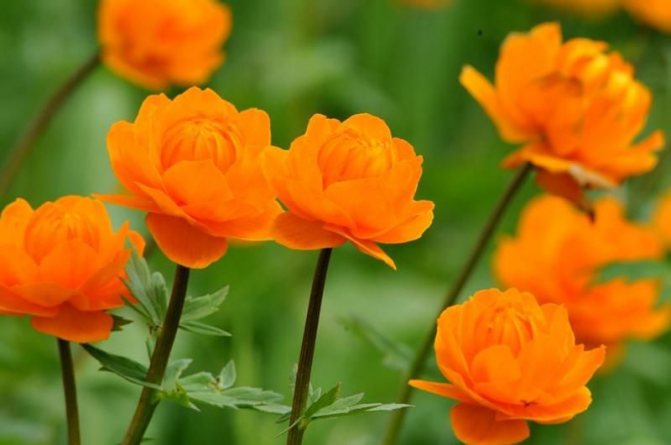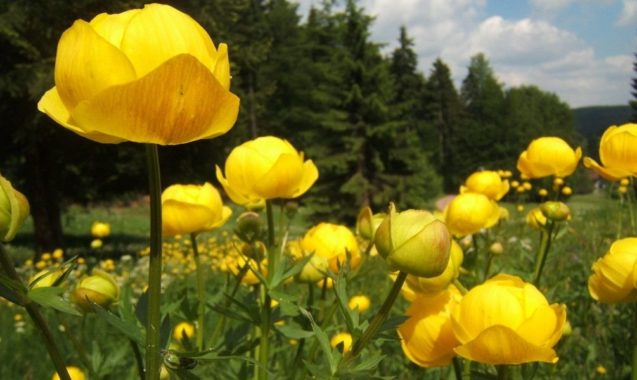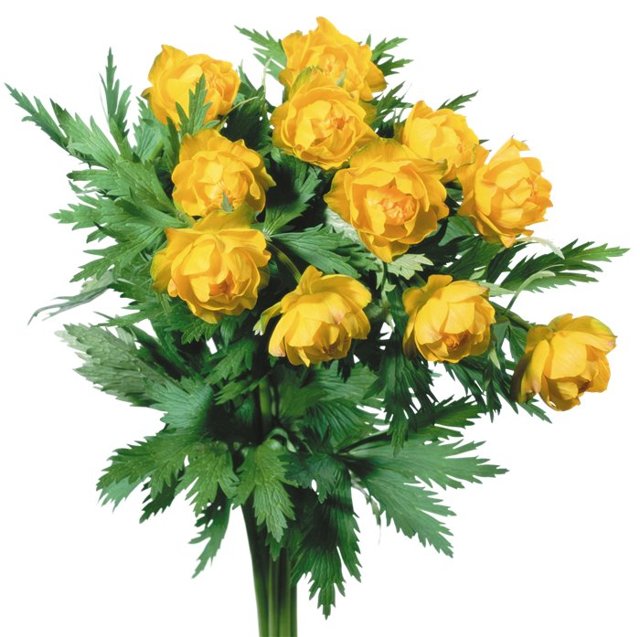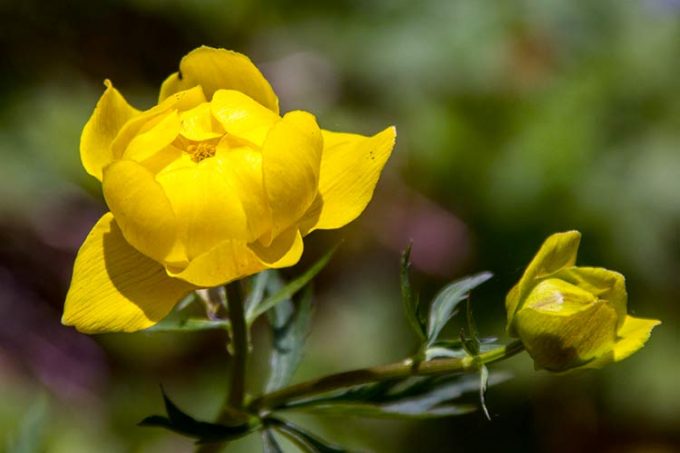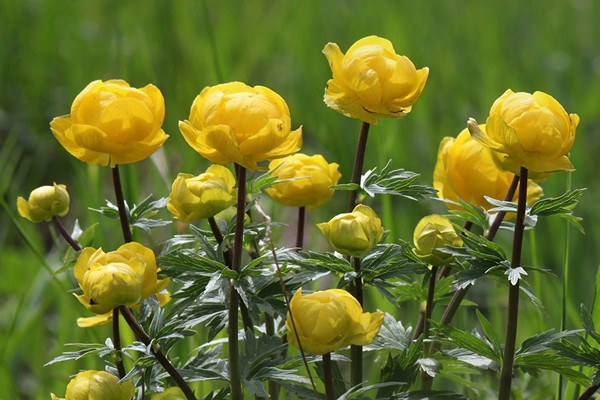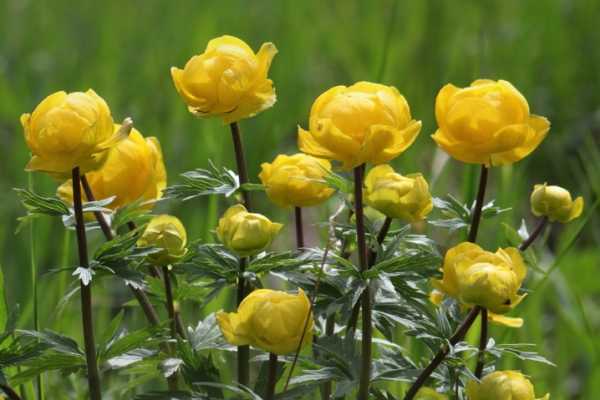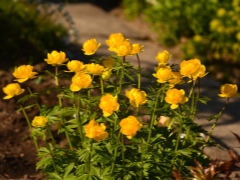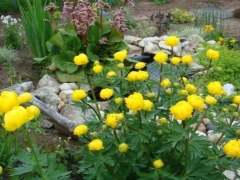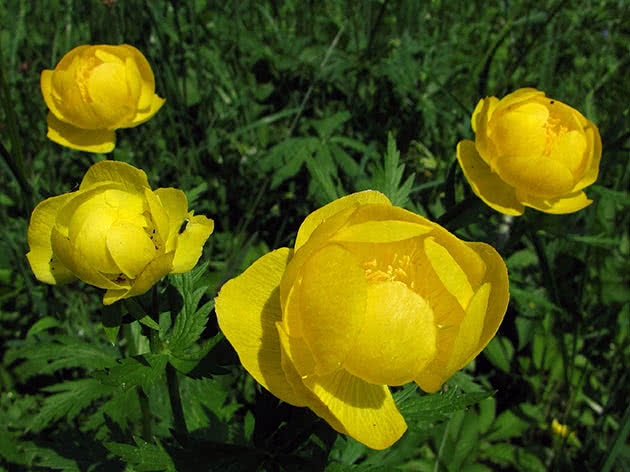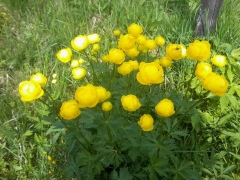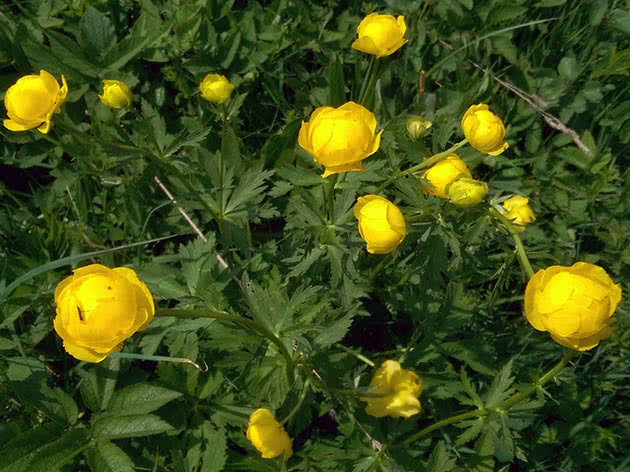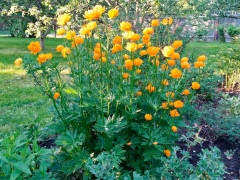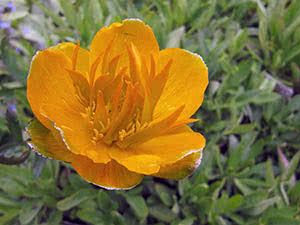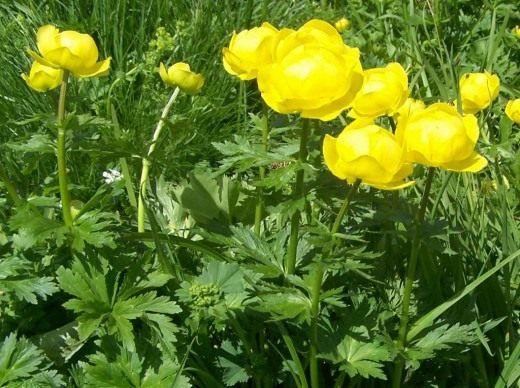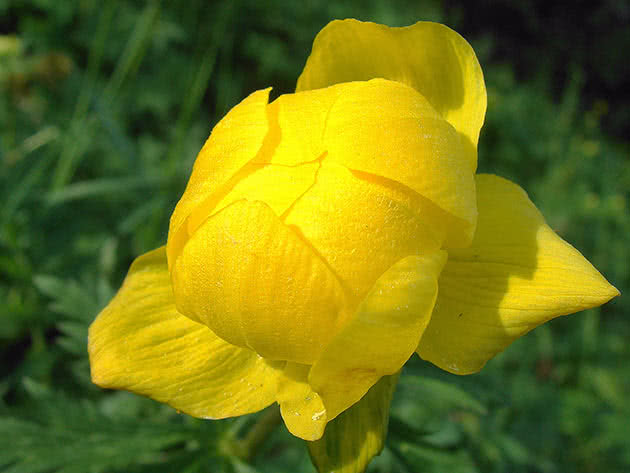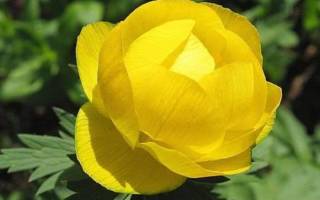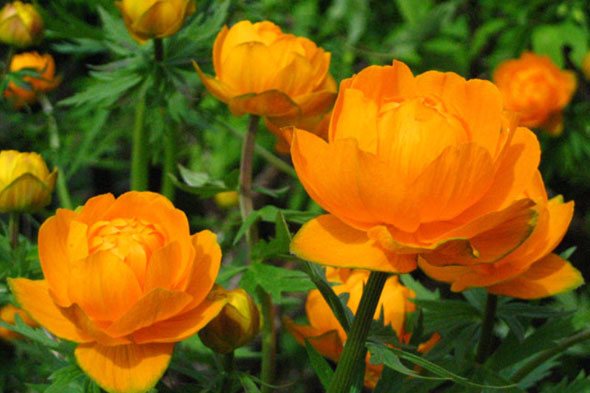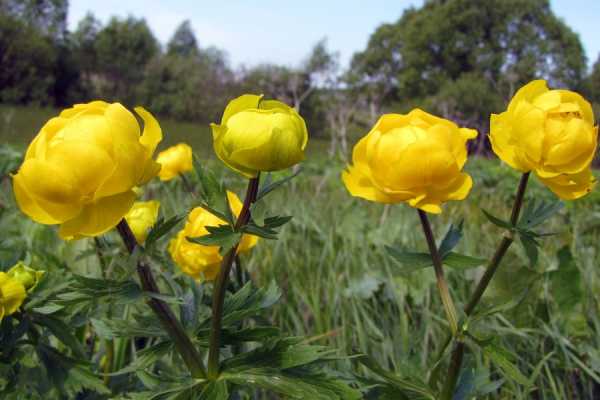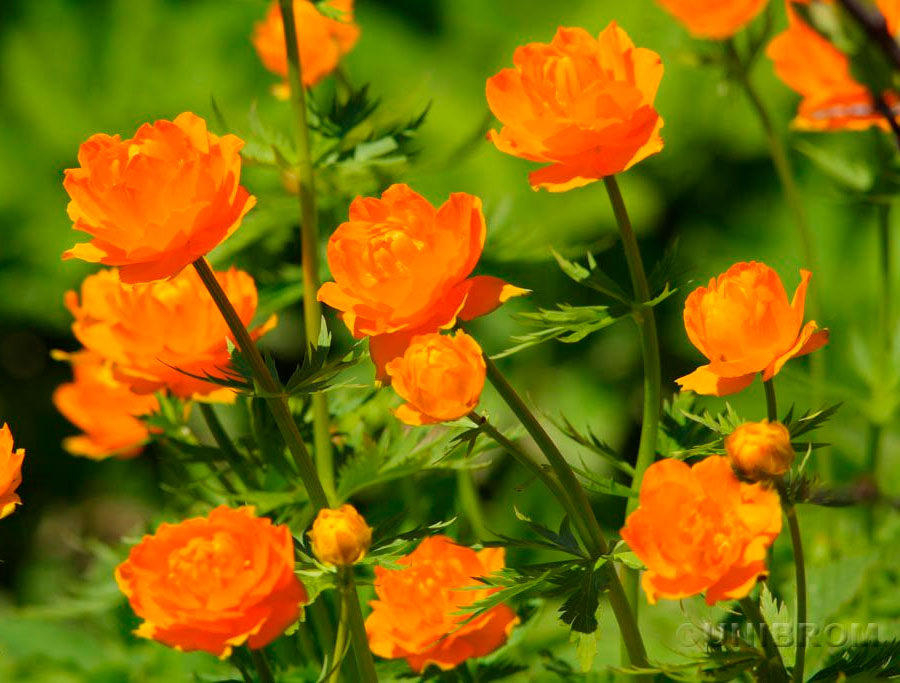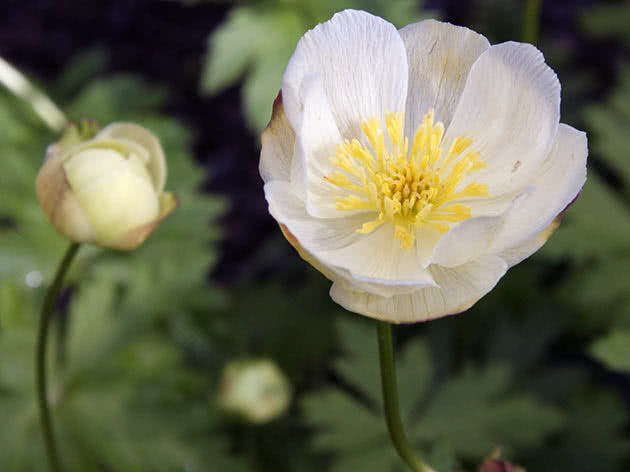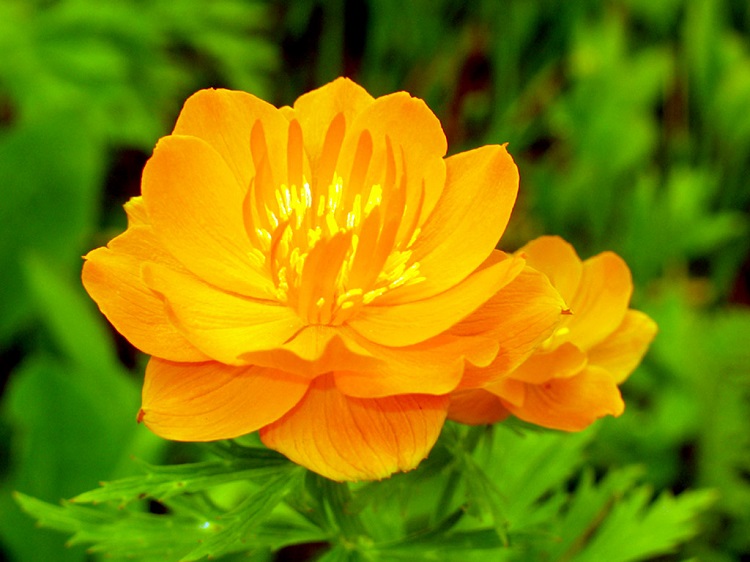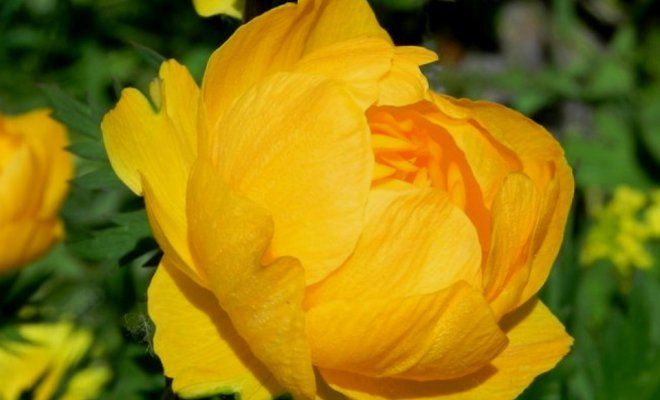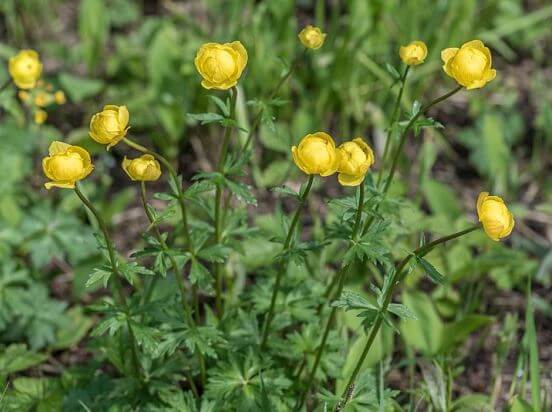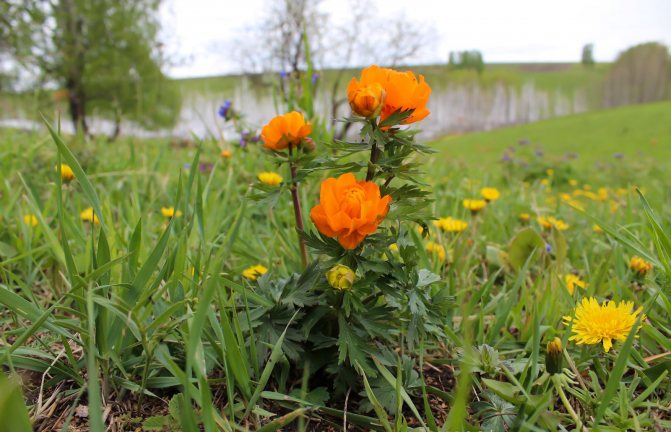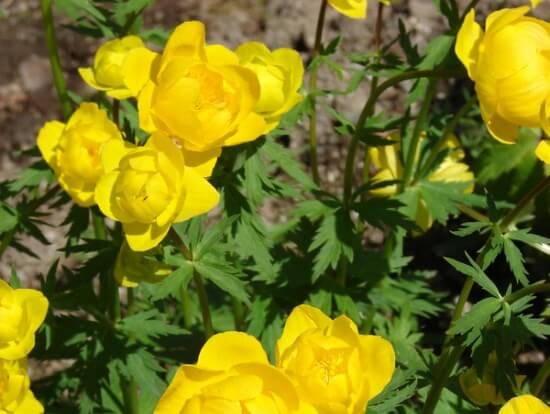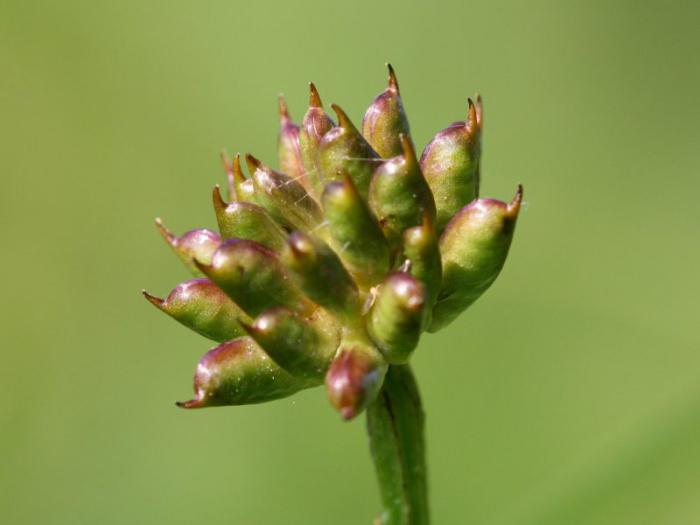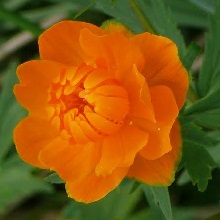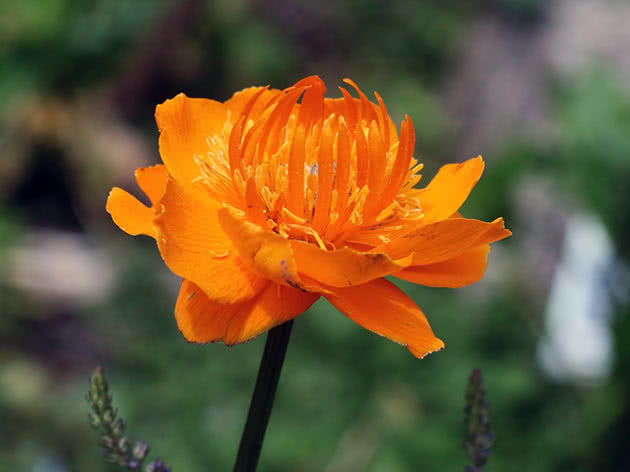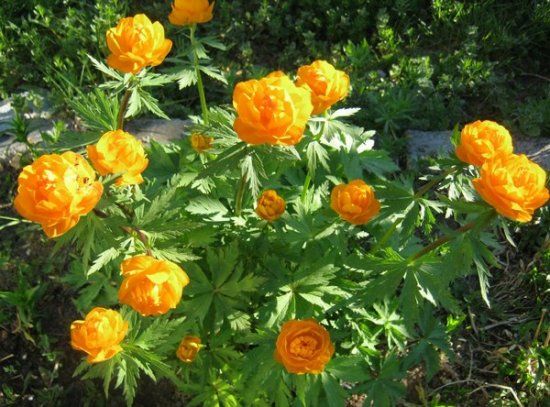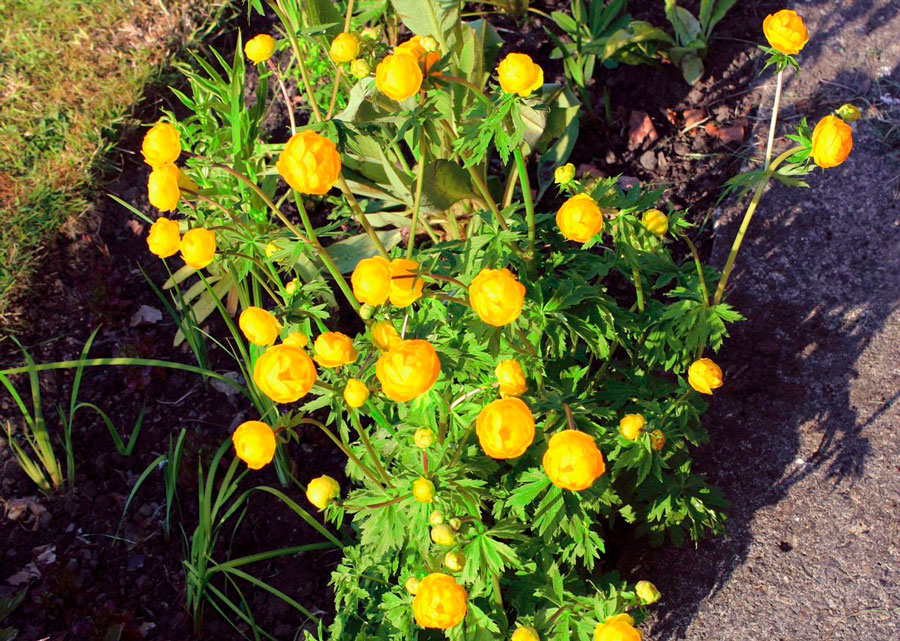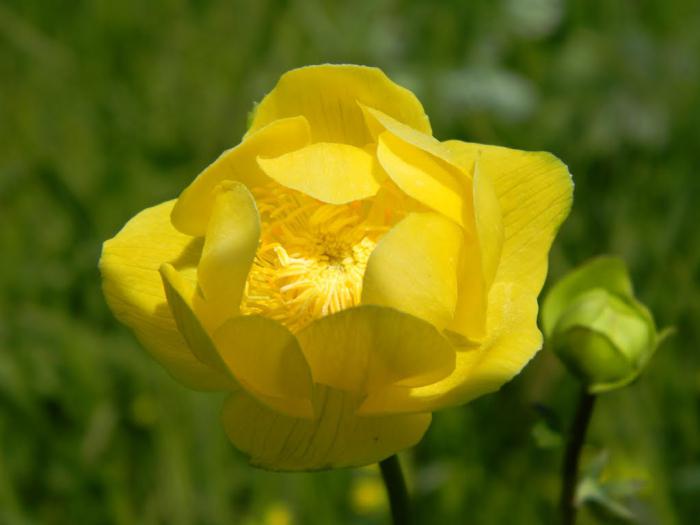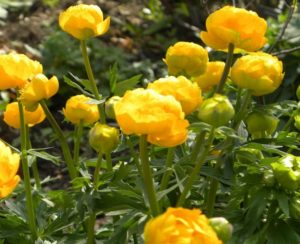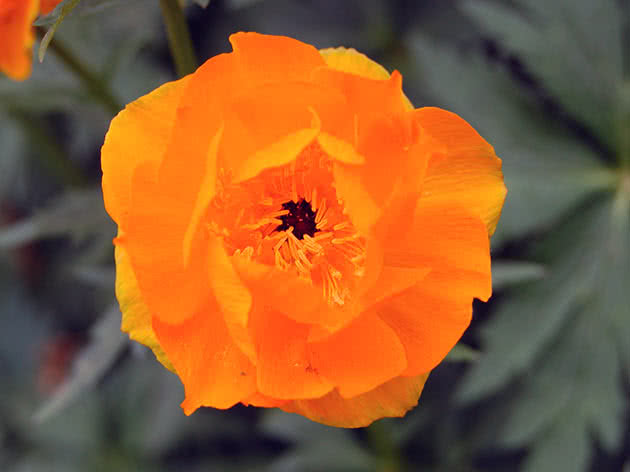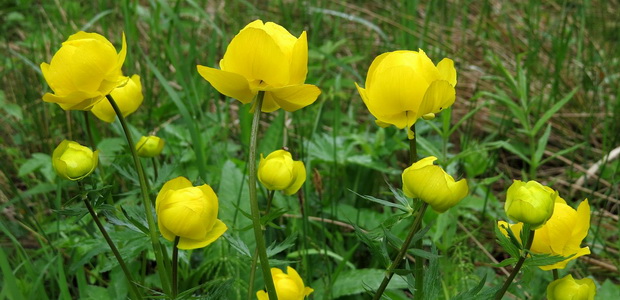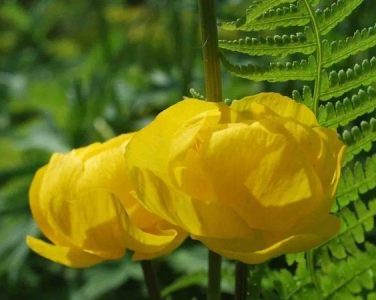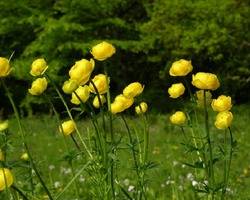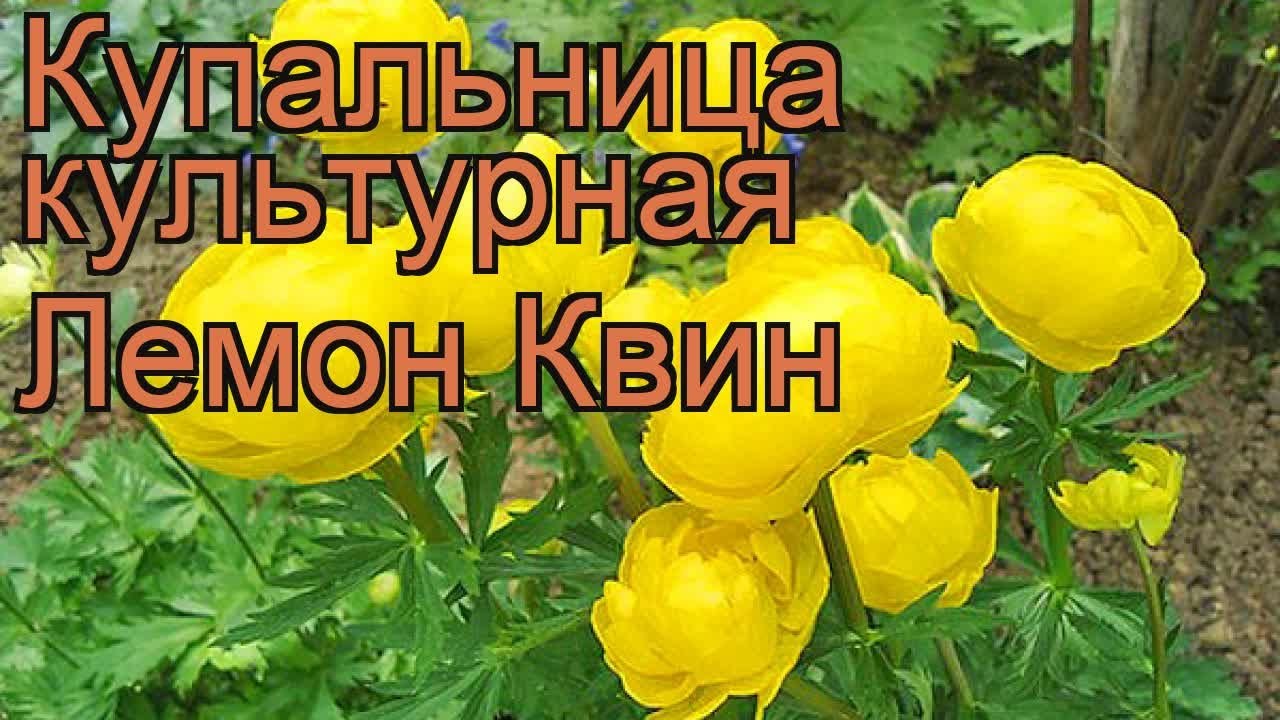Types of swimwear
Currently, scientists identify about thirty types of swimsuit, of which nineteen can be grown in the garden. Unfortunately, the wild-growing bather is present in the Red Book as an endangered plant. Below are descriptions and photos of the most popular decorative varieties.
European swimsuit (Trollius europaeus)
Under natural conditions, the plant is widespread in Northern and Central Europe, Scandinavia and Western Siberia. The description of this plant says that it is most often found in forb meadows, forest edges and clearings near water bodies.

In the photo you can see how the plant blooms.
Asian swimsuit (Trollius asiaticus)
This species can be found in Siberia, Altai and Mongolia. The flower grows on wet soils of floodplain meadows, next to forest bogs and lakes. The Asian swimsuit is also found in the tundra at the border of the permafrost. According to the description of the species, the height of the stem can be from 10 cm to one meter.
The plant forms terry inflorescences of a bright orange hue in the shape of a ball. The petals expanding towards the top are arranged in several rows in the inflorescence. Flower diameter - about 6 cm. The Asian swimsuit blooms from the end of May for three weeks.
Terry hybrid varieties of Asian swimwear can often be found in flower beds created by professional landscape designers.

Dzungarian swimsuit (Trollius dschungaricus)
In nature, the flower is found in the Dzungarian mountains and in Altai. This is a low-growing plant, naturally reaching a maximum height of 15 cm.In flower beds, with proper care, the plant can grow up to 50 cm.
The swimsuit has bright yellow open inflorescences. Wide petals are located almost horizontally. The leaves collected in a rosette are located close to the ground. The flowering period is in the first half of summer.
Purple swimsuit (Trollius lilacinus)
A plant with a rare color in nature is found in the highlands of the Tien Shan and Altai. The purple bather blooms at the end of June on the border of the melting snowfields.
The plant forms inflorescences with light lilac petals and yellow stamens. The flower is undersized. The maximum stem height is only 10 cm.
The purple swimsuit grows well only in specific natural conditions. In gardens, it takes root very rarely.
The relative unpretentiousness and unobtrusive beauty of the swimsuit make it possible to use this flower to decorate any area. The monochromatic color and laconic shape of the troll flower make it an excellent addition to a wide variety of flower beds and flower beds.
Popular varieties of swimwear
Only a few varieties are cultivated:
Up to 5 cm, from pale yellow to golden lemon. The sepals are bright orange, identical in size to the petals.
Up to 5 cm, reddish-scarlet. The nectars are widened upwards.
Late spring to mid-summer.
Up to 6 cm, solitary, half-open. Orange or golden sepals are 2 times as long as rusty petals.
Up to 8 cm, open, with wide, rust-colored oval petals.
Second decade of summer.
Located on a branched inflorescence. Up to 6 cm, greenish-amber.
Single, open and half open. Reddish petals are thin, elongated.
Flat, bright lemon, in some varieties with a reddish tint.
The end of spring is the first decade of summer.
Large, with orange, open petals.
Lilac, with amber stamens on peduncles up to 10 cm.
Golden, on underdeveloped pedicels, lengthening when the fruit ripens. The petals are narrowed, linear, half-open.
Accommodation in the country
Swimwear is planted near water bodies, under trees, in mixborders.They give wonderful contrasting combinations with blue forget-me-nots.
In a shady mixborder, ferns will provide them with a luxurious openwork background.
European swimsuit with ferns
In addition, their partners can be:
- hosts;
- bought;
- daffodils;
- Siberian irises;
- geraniums;
- primroses and others.
They look gorgeous when cut. In nature, it makes no sense to collect bouquets from swimsuits: without water, they will wither in half an hour.
Swimwear looks luxurious in the cut
Therefore, it is better to grow these beauties in your country house. Admire them in flower beds, and cut them in the early morning. And immediately place the flowers in a container of water.
European swimsuit: caring for the "poisonous beauty"
Caring for a swimsuit is simple, but in order for it to please the eye, it is important to understand well its character and preferences.
Abundance of watering
The swimsuit is very demanding on the amount of moisture.
Here it is important to "find" the golden mean: the soil should always remain moist, but without stagnant water. Therefore, the regularity of watering directly depends on external conditions: the hotter the summer, the more often watering
The mistakes made in this part, the European Trollius is difficult to endure only in the first years of his life.
Soil mulching
Mulching for the European Trollius is optional, although it is encouraged. Mulch protects the land from drying out, and the owner of the site from tedious weeding. But, of course, if the swimsuit is part of landscape design, this agrotechnical technique may not fit into the overall picture, so you should not worry too much about this. 
Pruning faded peduncles
In order for the "troll flowers" to develop better, at the end of the growing season, the stems are recommended to be cut radically, leaving about five centimeters above ground level. Fading peduncles also need to be cut off so that the plant does not lose its decorative effect. 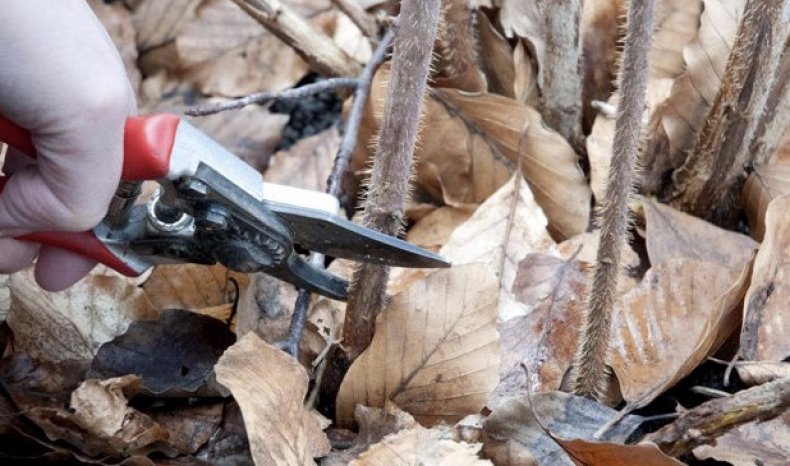
Pests and diseases
The described species is quite resistant to pests, but some fungal diseases may well cause him serious trouble. Since it is almost impossible to fight smut and septoria, prevention works best in such cases. To do this, it is necessary to get rid of dying leaves in time, prune and remove diseased plants in time.
Outdoor swimsuit landing
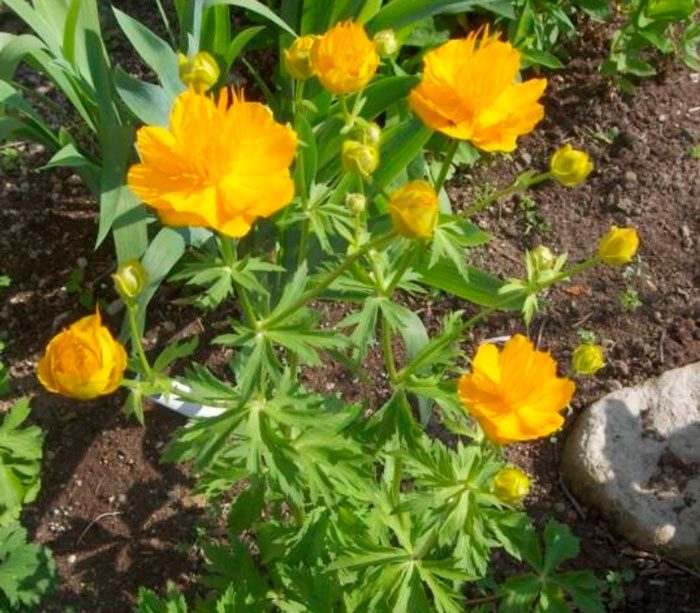
Sowing seeds
In the case when the swimsuit is grown from seeds, they need cold stratification before sowing. For example, seeds are sown in a container in autumn, after which they are transferred to an unheated room, where they are left until spring. During the winter, the seeds are naturally stratified, and seedlings appear in the spring. However, most often, gardeners mix freshly harvested seeds with moistened sand, poured everything into a bag, which is removed on the refrigerator shelf intended for vegetables. They should stay there for three to four months, while the optimum air temperature is 2-4 degrees. Sowing the prepared seeds in the soil mixture is carried out in March, after which the crops are placed in a sufficiently warm place (about 20 degrees). Seed germination is extremely slow, the first seedlings should appear from mid-April to early May. Seedlings will need protection from the direct rays of the sun, and it should also be noted that they react extremely negatively to overdrying the soil mixture. The pick is carried out when the second true leaf plate begins to form in the seedlings, while the distance between the plants is 80–100 mm. Planting seedlings in open soil is carried out in August.
How to fit a swimsuit
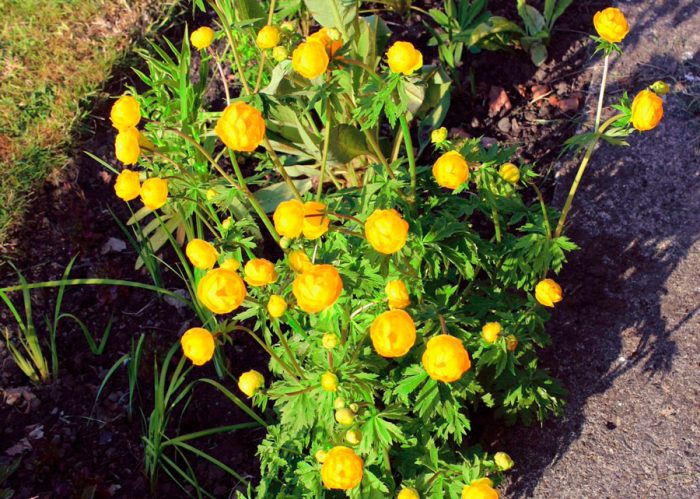
Under natural conditions, such a flower can grow in both shaded and sunny places. However, when planting in the garden, it is recommended for him to choose an open, sunny area, located away from bushes and trees.Structural soil is very good for growing a swimsuit, which should be light loamy or medium loamy, and it should also contain a large amount of humus. Also, light and nutritious soil must be neutral. To grow such a flower, you can also choose poor soil, but in this case it will be necessary to add humus combined with peat into it, such a mixture contributes to better absorption and retention of water in the ground. For 1 square meter of the site, 5 kilograms of a similar mixture are applied.
To begin with, you need to prepare the planting holes, the distance between which should be from 0.3 to 0.4 m. When planting, the seedlings are taken along with a lump of earth. Such a flower reacts negatively to transplants, so it can be grown in the same place for about 10 years. Bushes that have grown through seedlings will begin to bloom only in the third or fourth year of growth.
Swimsuit: reproduction
The plant can reproduce in different ways: by division, cuttings and seeds. Seeds are sown immediately after harvest or before winter in the ground or boxes. During sowing in the spring, seed stratification is required for 3 - 4 months at a temperature of 2 - 4 degrees. Seedlings appear in the spring. Amicable shoots appear in mid-May. They need watering when the soil dries out and shading. After the appearance of the 2nd true leaf, the seedlings dive at a distance of 8 - 10 cm from each other. You can plant swimsuits in a permanent place from the spring of the 2nd year or for 3-4 g.
The European swimsuit blooms for the 2nd year after germination. It can usually be found in Europe and Western Siberia. It forms a bush: the lower leaves form a basal rosette. In shape, they have palmate-separate leaves, of 5 toothed lobes along the edge. In the upper part, the stem of the European swimsuit can branch. The flowers are globular, dense and with a pleasant aroma, usually yellow in color. Flowering begins in late May - early June and lasts about 4 weeks. The seeds ripen in July, it is better to sow them freshly harvested or before winter in a specially designated shaded area in open ground. When the seedlings grow a little, they must be dived, leaving a distance of about 10 cm between the plants. Next spring, young seedlings can be planted in a permanent place in the flower bed. They will bloom in the same year.

The Asian bather forms a powerful bush up to 80 cm high. Outwardly, it resembles a European bather, only its flowers are more open and orange-red. Some buds have a double shape. The Asian swimsuit blooms in late May - early June. It depends on the growing area. The best way to propagate a plant is through seeds.
There is also a way of vegetative propagation. It occurs by dividing the curtain or separating several peripheral shoots from an adult plant along with roots. Division is best done in late August - early September, when the shoots are already formed in the buds and there is time before winter for their rooting.
The mother plant is dug up, the soil is shaken off the roots and washed well. Next, divide it into several parts with a knife. The size of the landing units can be arbitrary
It is important that each of them has several rosette shoots with roots. The surface of the slices is treated with a solution of potassium permanganate or ash
Make sure that the slices do not dry out.
Plants need to be planted quickly; for this, the planting places are prepared in advance. When planting, the root collar is buried 2 cm, keeping landing distance 30 - 40 cm.
Young ground shoots that appear in spring and summer rosettes with a part of the underground stem are taken for cuttings. They respond well to fertilizing with mineral fertilizers.
Reproduction of dicentra
Reproduction using seeds. Dicenter broken heart can multiply by cuttings, bush division and seeds.The latter method is the least common due to poor seed germination.
The seed retains its germination capacity for 2 years. Seeds are shiny, black. If a gardener decides to grow a dicenter with seeds, then you need to be patient. This plant will bloom only in a few years.
Seed propagation method:
- Sowing material is sown in September, in fertile and light soil.
- A month later, sprouts appear. When the seedlings get stronger, they dive and transplant it into pots.
- Seedlings can be planted outdoors in spring.
When it is a southern region with winters, where the temperature does not fall below 8 ° C, then the seedlings are immediately transplanted under a covering material or film into open ground.
Seedling care is standard - picking, airing, watering. This method of propagation is best left to professional gardeners, as a rule, they use the picky and simpler method - dividing the bush.
Reproduction by division
This breeding method is used once every five years. Thus, an adult bush is renewed and propagated at the same time. Breeding features:
In the spring, the plant is carefully dug up. The roots of the bush are rather fragile
Use a garden trident to uproot and undermine the plant.
Let the root system dry a little so that the roots become slightly flabby.
Cut the root into several divisions, approximately 12 cm long, with 3-4 shoots.
Delenki are planted in a permanent place with a step of 35-40 cm.
In the southern regions, the shrub begins to bloom in the second year, in the northern regions - only in the third. Young plants for the winter are certainly covered with a thick layer of mulch.
Propagation by cuttings
This is a fairly simple breeding method, which is often used by flower growers to reproduce bicentra:
- cuttings must be taken at the end of winter or at the end of spring, taking into account the type of dicentra;
- cut off a part of the stem with a heel 12–15 cm in size and rooted in fertile and light soil;
- before planting a stalk, it must be dipped into "Kornevin" or another composition to activate root growth;
- the pots with the seedling are covered with foil and moved to a warm place with a temperature of 19–21 ° C;
- a month later, the root system must appear;
- cuttings are transplanted into open ground only in the second year.
Caring for seedlings is no different from caring for other plants - periodic airing and watering before removing the film from the pots.
Swimsuit care
Caring for the swimsuit will consist in its timely weeding, watering, feeding and loosening the earth.
Young bathers need to be shed well in dry weather. The soil must be constantly mulched with a peat layer and humus.
For the purpose of good development of the plant, it is recommended to systematically add nutrient soil to the base of the bush bush.
In order to obtain secondary flowering, you can cut out faded flower stalks.
The plant does not require shelter for the winter, as it tolerates frost well.
Top dressing
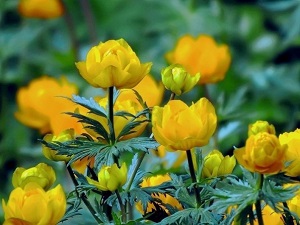
For the lush flowering of the swimsuit, it is enough to follow the basic rules of the course - feeding and pruning the plant
When growing a swimsuit, it is imperative to feed it. Top dressing occurs in small doses.
To prepare top dressing, you need to take 10 liters of water and dilute in it a tablespoon of nitrophoska, a tablespoon of urea, and a tablespoon of Agricola for plants.
Top dressing should be carried out in early May, repeating it in the period before the swimsuit blooms. After feeding, the plant will acquire the splendor and brightness of flowers.
Pruning
Leaves of the swimsuit remain decorative throughout the growing season. In September - early October, they die off.
Only after dying off, the leaves are cut off, and the base of the petioles remains 2-3 centimeters above the earthen surface.This is the protection of the bud located in the center of the rosette shoot, from which the peduncle appears the next year.
Swimsuit grooming in the garden
Trollius needs to be watered all the time, fertilized periodically and cut off dried shoots. If you adhere to these basic rules, the plant will grow quickly and will even delight you with double flowering per season.
Watering and weeding the swimsuit
The plant needs to be watered often, but no frills: the swimsuit should be in moist soil without stagnant water. Any deviations towards underfilling or waterlogging will negatively affect the growth and flowering of the crop. This moment is especially important in caring for young bushes.
Removing weeds is a must when looking after a swimsuit. To conserve strength, you can mulch the bush. This will maintain moisture near the roots and prevent weeds from drowning out the plant. But if the mulch does not fit into the landscape design, you can do without it.
Frequent loosening of the soil is also carried out to a depth of 2-4 cm, but not deeper, so as not to damage the fragile root system.
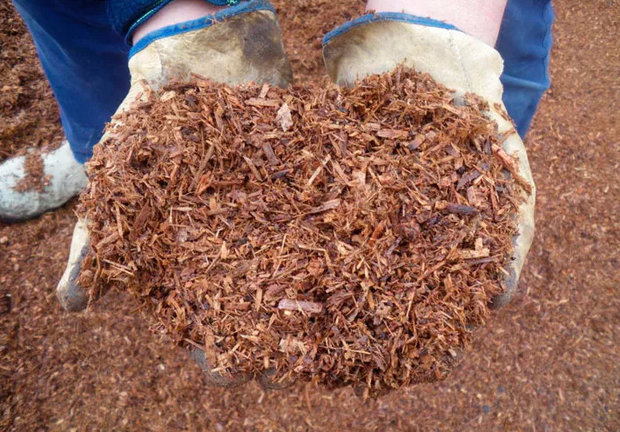
Using fertilizer for the swimsuit
The bather is an unpretentious flower, so you don't have to apply a lot of fertilizers. To enhance flowering, fertilization is carried out in the spring (it is better to do this before the flowers appear). Then, with an interval of two or three weeks, two more dressings are made.
For trollius, you can use nitrophoska (5 g per bucket of water), urea (1 tablespoon per 10 liters of water) or complex organic fertilizers (Agricol). The swimsuit responds well to the introduction of humus and peat.

Swimsuit pests and diseases
This culture is characterized by increased immunity to diseases. The only microorganism that can infect a swimsuit is a fungus. To avoid this, you need to adhere to the required watering regime and remove dried leaves in time.
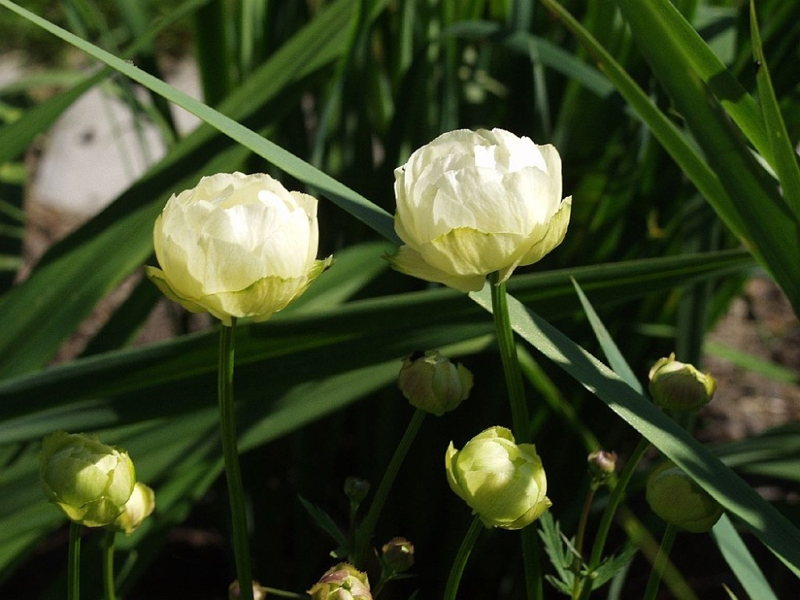
Agricultural technology of cultivation
The bather prefers neutral nutrient soils. The area where this plant is supposed to be grown should not be in the open sun. Otherwise, it is quickly depleted, the flowers become smaller, the duration of flowering is reduced.
This culture is very demanding for watering. Does not tolerate lack of moisture. Watering should be regular, accompanied by weeding and frequent loosening of the soil. The swimsuit's powerful root system requires constant oxygen supply.
Particular attention should be paid to feeding this plant. The procedure must be carried out every 10-14 days throughout the entire flowering period.
As a fertilizer, choose a universal top dressing for flowering species. The finished solution is diluted with plenty of water to reduce the concentration of the drug.
Sometimes the root system grows and becomes bare, in this case it is recommended to add fresh nutrient soil under each plant.
For the winter, only young plants are covered in the first year of life. To do this, use spruce branches or fallen leaves. Older specimens tolerate the cold, snowless winters of the middle lane perfectly.
Swimsuit hybrid varieties
We have already mentioned above where the European swimsuit lives, and talked about the fact that this flower looks differently in different regions. But there are also artificially bred hybrids of this plant. Of the three dozen such varieties, the vast majority can be found on the territory of the CIS states, but there are varieties of swimwear that grow even in Asia and America.
In addition to growth, varieties of European, Caucasian, Asian, Altai and Chinese swimsuits differ from each other in texture and color of flowers (they are presented in a wide palette from white to bright orange and come with ordinary or double petals). 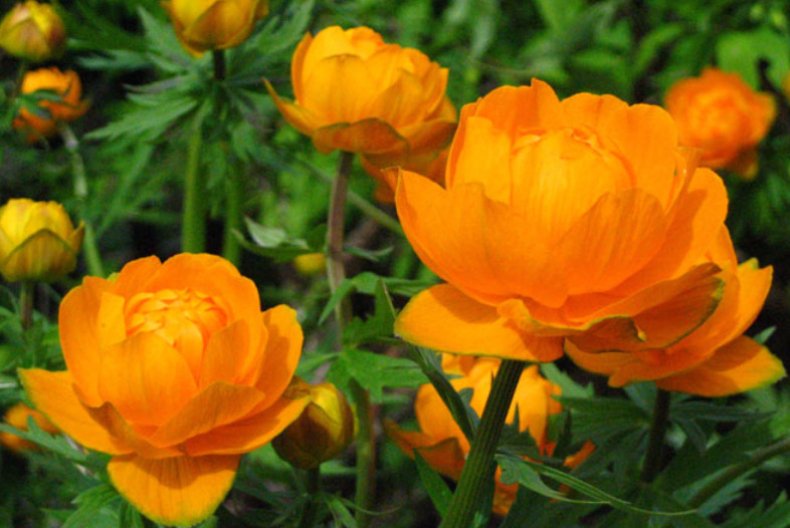 The most interesting hybrids of the European Trollius include:
The most interesting hybrids of the European Trollius include:
- yellow - Dzungarian, Canary Bird, Light Ball, Lemon Queen, Goldquel, Lidebura, Ridera;
- orange - Altai, Fire Glob, Goliath, Orange Princess, Orange Quest, Orange King.
A very original hybrid of Trollius with light beige large flowers, which is called Alabaster, it is also impossible to confuse a purple leotard with a large number of lush blue and white petals, similar to a ballerina's tutu.
All of the above varieties of Trollius are conventionally classified into cultural and hybrid. A distinctive feature of the swimsuit is that the care and cultivation of this plant does not require much effort, although, of course, this rule applies if the variety you choose is ideal for the climatic zone in which you are going to plant it.


